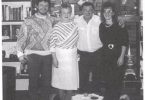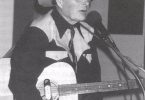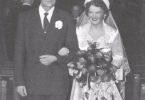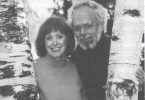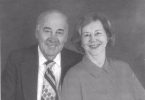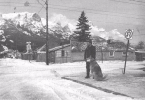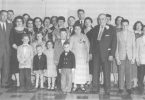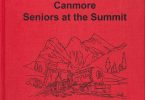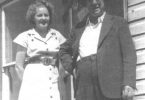An Autobiography
I feel I have had a good life, full of “adventures” – some interesting and some not so interesting. I was born a long, long time ago (actually 1921 on what, according to my mother, was the hottest day of the century up to that time) in Bradford, West Yorkshire, England, taking my school education there and being active in high school sports and the Boy Scout movement. I had thoughts of entering university and possibly entering the ministry. However, while still in high school, the outbreak of World War II dashed those hopes.
I left school in the summer of 1940 and worked for a short while at the Wartime Wool Control. As I had often expressed a desire to join the Royal Navy but had been turned down by the Naval Officers’ Training School (my eyesight was 25/20 in one eye), I accepted my father’s offer of entering a Wireless School and attained my Radio Telegraphy Certificate. In late June 1941, I received my first assignment as Third Radio Officer on a tanker which carried mainly aviation high octane gasoline!
I made three trips across the North Atlantic in convoy to the U.S.A. and survived an air raid in the North Sea off the Humber estuary with a full load of aviation fuel. In early 1942, I joined a freighter and made two trips to Canada for a cargo of grain. On the first trip, I left Bedford Basin, (Halifax, Nova Scotia) on Easter Sunday and encountered a North Atlantic hurricane. Heavy seas restricted the vessel to four nautical miles in one four-hour watch. The deck plate cracked and flooded one boiler room. We had to shut down the boiler but fortunately, the sea water did not “hit” the hot boiler. We managed to “limp” into St. John’s (Newfoundland) the following Saturday afternoon. Several other damaged ships had arrived earlier so we had to wait several days for repairs. On the second trip, I spent my twenty first birthday doing “sabotage watch”, anchored in the St. Lawrence River off Trois Rivieres (Three Rivers), Quebec, loading ammunition! On one of these voyages, the convoy had to sail north through the Belle Isle Straits to avoid the U-boats. The convoy sailed north in two columns and the icebergs sailed south in three or four columns! It was quite a sight to look UP from the ship’s bridge to see the tops of those icebergs.
The next vessel was a twin-screw vessel, capable of fifteen or more knots, so we left the convoy our first night out from England and headed alone for the Panama Canal – what an incredible feat and sight that is – then, across the Pacific Ocean to Melbourne and Sydney, Australia; then back to England, also via the Panama Canal.
Next, I joined a bulk ore carrier, owned by Saguenay Terminals of Montreal (a subsidiary of Aluminum Canada) but sailing under the British flag and registry. After loading a cargo of bauxite ore (for aircraft aluminum), we sailed in a small coastal convoy from Secundi/Takoradi (in what was then the Gold Coast), for Freetown, Sierra Leone. On the Friday evening before we were due to arrive in Freetown, the vessel was torpedoed at about 8:00 – 8:15 p.m., April 30, 1941. Fortunately, as the vessel was built as a bulk ore carrier, it had special hatch covers – this gave us a chance to “abandon ship”. Unfortunately, only one lifeboat was undamaged and seaworthy, so overboard, many of us had to go! I met up with three other crew members, two of whom were injured, and we kept together. The next morning, a Sunderland FlyingBoat spotted us and dropped an Airforce lifejacket which had a chlorine pad – that kept away the barracuda which had been circling us for a long time. Later that day, he returned and dropped a two-man inflatable dinghy into which we were able to put the injured. Early next morning, a Royal Navy M.I. searching for survivors spotted us, picked us up and took us to Freetown where we had to wait a few days for a passage back to England. I spent about four months on “Survivors Leave” (one month with full pay), then on a 100 percent pension for “nervous debility” before being able to return to sea, this time with a “promotion” to Second Radio Officer.
Later I was awarded the M.B.E. (Member of the British Empire) from King George VI at an Investiture at Buckingham Palace. Stuart Byatt and parents at Buckingham Palace the day he received his medal September, 1943, saw me back at sea again in another “faster” vessel, sailing out of convoy to South America, to Buenos Aires in Argentina and to Montevideo, in Uruguay, for cargoes of frozen meat. On the second trip, we headed to Taranto in Southern Italy (to feed the troops!). While there, we could hear the shooting at Bari. There was a curfew at 8:00 p.m. as there were still some snipers in town. The Military Police and Naval Shore Patrols travelled in pairs, with at least two members in each vehicle. Anyone in town after 8:00 p.m. was “picked up” and put in “protective custody” overnight! It was whilst I was serving on this vessel that we heard about the D-Day landings.
Home again for a while, I obtained my regular Radio Certificate so joined my next ship as First Radio Officer and joined a “tramp” steamer (“any cargo anywhere”). I travelled just about everywhere – through the Mediterranean, Malta, Suez Canal (a lot different than going through the Panama Canal), Aden, Bombay (where I won the competition for growing the best moustache between Aden and Bombay – guess I was good at something! – and won a “free night” at the local canteen at the expense of my shipmates!), across the equator again to Lourenco Marques (now Maputo), back to the south end of the Suez Canal, unloading at Port Tewfik (or Port Taufiq), through the Canal to Tripoli, then Oran (both in North Africa), across the Atlantic to Brooklyn, back across the Atlantic to Naples (where I visited the Ruins of Pompeii, and saw the opera “Carmen” at the famous Opera House), down to Oran (where I attended a memorial service for the late President Roosevelt on board a U.S. naval vessel), across the ocean to Baltimore (confined to the dockyards for V.E. day due to downtown rioting!), then sailed in our last convoy as the Atlantic was now declared a “safe” zone, and then to Alexandria, Egypt. I was now sailing independently, standing radio watches instead of assisting on the bridge watches, to Norfolk (Newport News) before heading to Beaumont,Texas, where we celebrated V.J. Day – no riots here but excellent celebrations where all were welcome. I returned to Europe, to Rotterdam in the Netherlands – the devastation from the bombings was beyond belief. I finally returned to England after an absence of one year.
After a four-week leave and hearing that I had load of lumber at Port Tahsis on Vancouver Island and then back to England. The next trip was to Singapore, Shanghai, across the North Pacific to Portland, Oregon, back to Singapore and then to Vancouver and New Westminster – another trip to Calgary sealed my future fate (I got engaged). I returned to England, having circumnavigated the world, and resigned from the Merchant Navy, and I must admit, that except for a very few incidents, I really enjoyed my life at sea.
After getting all my papers duly signed and approved, I sailed for Canada (a one-way ticket this time), arriving in Calgary early May, 1947. I took the fateful plunge and married in June 1947.
We honeymooned at Waterton National Park. My wage was only $32.50 per week but rent was only $25.00 per month; beer was $2.25 per dozen (all bottles, no cans then, and no deposit); groceries, all you could carry in your arms, cost $5.00 to $10.00. I had a few “mixed” jobs at first – gas jockey, construction of St. Mary’s River Dam in Southern Alberta, parts department of heavy construction equipment, and street car and bus driver for Calgary Transit.
Our son was born in 1950 and I had started to build my own house in Highland Park. A CPR Express tangled with the old steam engine on the evening train from Edmonton on Halloween in 1951 (thus the scar on my forehead) – the train engine won! I was due to start a new job the next day so it had to wait. That was the start of almost fifteen years as a Civilian Member in the Telecommunications Section of the R.C.M.P. Many tales I could tell – remember when the R.C.M.P. Detachment in Canmore consisted of one member, then raised to two members in a house on Rundle Crescent (now occupied by a well-known Canmore couple)? In those days, this was outside the town limits but in the I.D. #8, close to where the old arena used to be. In 1966, I took my discharge and obtained a bursary from the Calgary Catholic School Board and attended the University of Alberta in Edmonton, where I eventually obtained my B.Ed.(Voc). In 1967, I started teaching at St. Francis High School in Calgary, teaching mainly Vocational Education, coached and refereed both soccer and volleyball, before retiring in 1987. In the early ’70’s, I bought a lot in Teepee Town and built another house and became one of those so called “weekenders”! This allowed myself and family (now two sons and three grandchildren) the opportunity for plenty of skiing and hiking in the Bow Valley.
Many changes have occurred since that time, especially after the 1988 Winter Olympics. Now a full-time resident of Canmore,I became involved with the “town life”. During the Olympics, I worked for the town as a dispatcher at the Emergency Services (I guess my years dispatching for the R.C.M.P. helped me obtain this position!). I had also worked as part of the Calgary City Police Volunteers in Calgary at the Accreditation Centre, mainly before the Olympics started. Since that time, I have had part-time employment as a substitute teacher at both the Canmore and Banff High Schools, worked on the annual Town Census, and become a member of the Canmore Seniors (active with the Duplicate Bridge Club). I have been a member of the Canmore Protective Services Advisory Committee (and its predecessor, the Canmore Police Committee) and have been an Income Tax Volunteer. I have refereed both soccer and volleyball in Canmore and Banff, attended (and voiced my verbal and written comments and opinions) many public hearings and open houses – generally being a “pest” to Town Council officials and employees! During this time, I and my family have enjoyed hiking and camping, in and around the valley and mountains, with a tent trailer, then a motorhome, plus a holiday, many years ago, in Mexico, and vacation trips back to England to visit family and friends, plus some sightseeing in Great Britain and the Continent. We also visited Disneyland in California and later, Disneyworld in Florida. Life and health have generally been good to me and my family.
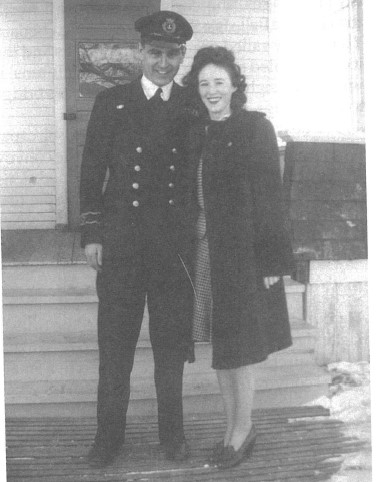
Stuart and Jane Byatt
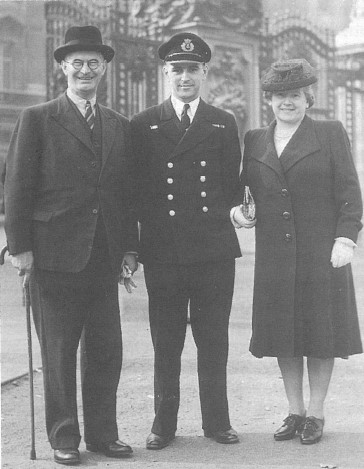
Stuart Byatt and parents at Buckingham Palace the day he received his medal
In Canmore Seniors at the Summit, ed. Canmore Seniors Association, 2000, p. 26-29.

